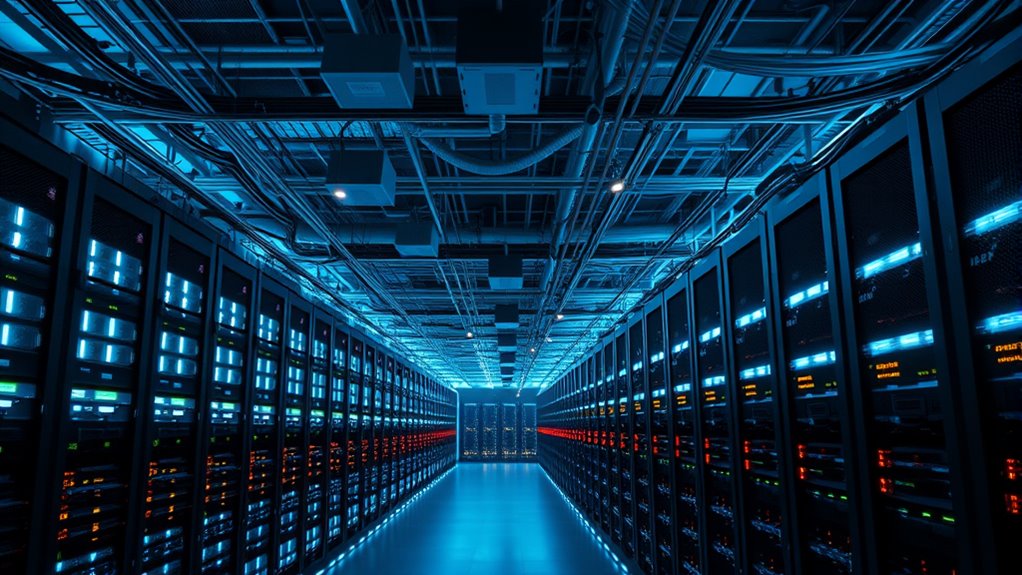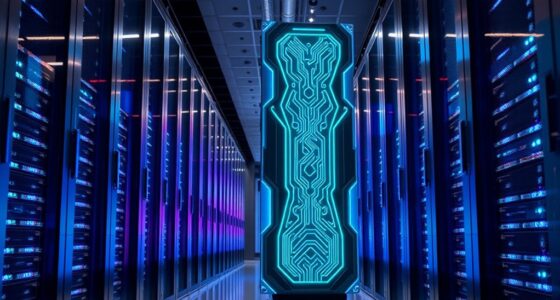As your data needs grow, the power grid faces increasing pressure from the rising energy demands of data centers. While integrating renewable sources like solar and wind can help, their variability creates stability challenges. That’s where energy storage solutions come in, storing excess energy for when it’s needed most. The future looks promising as industry and governments push for greener practices, but you’ll want to explore how these solutions work together to keep the grid reliable for the digital age.
Key Takeaways
- Growing data center energy demands strain existing power grids, risking capacity shortages and outages.
- Renewable energy integration reduces grid reliance but introduces supply variability challenges.
- Energy storage solutions help buffer renewable fluctuations, enhancing grid stability for data centers.
- Combining renewables with storage improves resilience, ensuring data center operations remain uninterrupted.
- Increased adoption of green energy and storage strategies is vital for sustainable, reliable power supply.

Are data centers running out of power? It’s a pressing concern as their energy demands continue to skyrocket. These facilities are the backbone of the digital age, supporting everything from cloud computing to streaming services. But as they grow, so does their energy consumption, putting immense pressure on the existing power grid. To keep pace, data centers are increasingly turning to renewable integration. This means harnessing solar, wind, and other clean energy sources to supplement traditional power supplies. By integrating renewables directly into their operations, they reduce reliance on fossil fuels and help ease the burden on the grid. However, renewables alone aren’t enough, since their intermittent nature can cause supply fluctuations. That’s where energy storage comes into play. Storage solutions, like advanced batteries, allow data centers to store excess renewable energy during peak production times and draw from these reserves when renewable output dips. This combination creates a more resilient, reliable power system that can adapt to fluctuating demands and renewable variability.
You might think, isn’t energy storage expensive? While the upfront costs can be high, the long-term savings and stability benefits often outweigh the initial investment. Storage systems help smooth out supply and demand, preventing outages and reducing the need for costly backup generators. They also enable data centers to operate more sustainably by maximizing the use of renewable energy when it’s available. This synergy between renewable integration and energy storage is transforming how data centers manage power. Instead of just consuming grid energy, they’re becoming proactive participants in cleaner energy ecosystems. As a result, they’re less vulnerable to grid disruptions and price spikes, which can occur during peak usage times or grid failures.
The push for renewable integration and energy storage isn’t just about sustainability; it’s also about operational resilience. With these technologies, data centers can better handle surges in data traffic and unpredictable grid conditions. This proactive approach helps maintain uptime and performance, essential for their critical functions. Furthermore, governments and industry standards are increasingly encouraging or requiring greener energy practices, making these investments even more attractive. As you look ahead, the trend toward renewable integration and energy storage will only accelerate. These solutions are crucial not just for avoiding power shortages but for ensuring a sustainable, resilient future for data centers and the digital infrastructure they support. So, the question isn’t just if the grid can keep up—it’s how data centers can lead the way in creating a smarter, greener energy landscape.
Frequently Asked Questions
How Are Data Centers Implementing Renewable Energy Sources?
You’re seeing data centers actively implement renewable energy sources through solar integration and wind partnerships. They install on-site solar panels or buy clean energy credits to power operations, reducing reliance on fossil fuels. Many also partner with wind farms to secure sustainable energy supplies. These initiatives not only lower carbon footprints but also enhance energy resilience, helping data centers stay efficient and environmentally friendly while supporting the grid’s shift to greener energy.
What Backup Power Solutions Do Data Centers Use During Outages?
During outages, you rely on battery backup systems and generator solutions to keep your data center running smoothly. Battery backups provide immediate power support, bridging the gap until generators kick in. Generator solutions then supply sustained, reliable energy, ensuring your operations stay uninterrupted. These backup power solutions are essential for maintaining data integrity and avoiding costly downtime, especially during grid disruptions or extreme weather events.
How Does Increasing Data Demand Affect Grid Stability?
You may not realize it, but increased data demand can cause grid congestion, threatening stability. As demand forecasting becomes less accurate with rapid growth, the grid struggles to keep up, risking outages. A recent statistic shows data centers now consume over 1% of global electricity, highlighting their impact. This surge forces the grid to adapt quickly, or else it risks overloads and failures during peak times.
Are There Regulatory Incentives for Sustainable Data Center Operations?
Yes, there are regulatory incentives for sustainable data center operations. You can benefit from policy incentives like tax credits and grants that promote energy efficiency. Carbon regulations encourage you to reduce emissions, pushing data centers toward renewable energy sources. These measures aim to lower environmental impact and promote sustainable growth, making it easier for you to operate responsibly while complying with evolving standards.
What Innovations Are Emerging to Improve Data Center Energy Efficiency?
You’re seeing cooling innovations like liquid cooling and free cooling techniques improve efficiency, reducing energy consumption. AI optimization also plays a key role by dynamically managing workloads and cooling systems, ensuring ideal energy use. These advances help you lower operational costs and lessen environmental impact. As these technologies evolve, your data center can become more sustainable, resilient, and capable of handling growing data demands without overburdening the grid.
Conclusion
You might worry that the grid can’t handle the surge in data center power demands, but remember, innovation is constantly evolving. If we work together, investing in smarter, more efficient energy solutions, we can overcome this challenge. Don’t let fear hold us back from progress. Instead, see this as a call to action—our future depends on how we power and protect our digital world. Together, we can turn this crisis into an opportunity for change.










